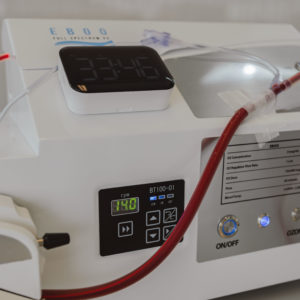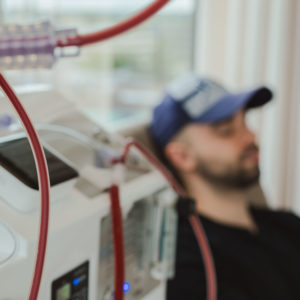5 min|Integrative
Mitochondria (Part 3): Early-Onset Mitochondrial Dysfunction
Wellness, Health, EducationThe health of our mitochondria is critical to our overall health
In Part 1 and Part 2 of our series, we learned about the impressive array of tasks carried out by the mitochondria, and discussed the detrimental effects of dysfunctional mitochondria. Although the mitochondria are small, and not something we often think about, it is clear that their health determines our overall health; when their inner workings go awry, we feel the effects.
There is a predictable decline in mitochondrial function that occurs as we age that, so far, is thought to be inevitable. But, for many of us, the decline in mitochondria functioning is occurring early, and at a heightened rate. Dr. Frank Shallenberger, MD, refers to this as early-onset mitochondrial dysfunction (EOMD).(1) The faster our mitochondria deteriorate, the quicker we age, and the more likely we are to experience mitochondria-related disease.
Early-onset mitochondrial dysfunction (EOMD) is characterized by certain biochemically changes within the mitochondria:
1. Poor oxygen utilization
In Part 1, we learnt all about how certain molecules act as a shuttle system within the electron transport chain (ETC) of the mitochondria, passing negatively charged electrons along, via proteins, towards the end of the chain where energy (in the form of ATP) will be produced. This process requires that electrons and positively-charged protons work together, in order to harness enough energy to make ATP.
This process is fairly efficient, with protons and electrons working as a happy couple moving along and across the shuttle system. However, every so often, protons ‘leak out’, leaving their partner electron hanging around on its own. Now remember - it’s negative, and now it’s also lonely! Our mitochondria scrambles, grabbing oxygen to pair with the wayward electron; in this process, reactive oxygen species (ROS) are formed (cue the dramatic music). This process is known as ‘inefficient coupling’.
No, this isn’t a euphemism for single-life; it’s referring to lonely electrons that ‘use up’ oxygen, depleting the mitochondria of oxygen, thus slowing down the ETC and production of ATP, and producing harmful ROS in the process. Decreased levels of ATP and increased ROS are unsustainable; this combination accelerates aging, and influences the development of certain diseases. Basically, the less energy and more cellular damage we have, the older and sicker we get.
2. Increased Reactive Oxygen Species Production
Inefficient coupling is harmful due to the increased oxygen it requires and the decreased efficiency of ATP production that results. But the ROS produced in the process are also destructive. Reactive oxygen species, also known as free radicals, have a single, highly reactive electron in their outer shell that can damage cells. Free radicals leach out of the mitochondria, into surrounding cells, creating unwanted damaging reactions.
Our body attempts to mitigate the effects of free radicals by utilizing antioxidant-buffering enzymes, but an excess of free radicals overwhelms these enzymes, leading to a phenomenon of cellular damage known as oxidative stress. Oxidative stress has been linked to a wide-variety of degenerative diseases such as atherosclerosis, cancer, diabetes, senile dementia, inflammatory joint disease, and degenerative eye disease.(2)
Many of the enzymes that neutralize free radicals are manufactured within the mitochondria and require ATP in order to be produced. Inefficient coupling reduces our mitochondrial capacity to produce ATP while also producing free radicals. We end up with too many of the bad guys (free radicals) and not enough of the good guys (enzymes); this imbalance is thought to be a major contributor to the process of aging.(3)
3. Reduced recycling
As you may recall from Part 1, we require adenosine diphosphate (ADP) and inorganic phosphate in order to make energy, in the form of adenosine triphosphate (ATP). Through the complex process of the ETC, ADP and phosphate is converted into ATP, which is then released from the mitochondria, into the fluid portion of the cell (the cytosol), where it releases energy, and is broken back down to ADP and phosphate.
In order to make more energy, we need to recycle the ADP and phosphate, bringing them back into the mitochondria to make more ATP. The whole cycle repeats, and repeats, making us energy when we need it.
But what happens if we are not bringing ADP and phosphate back into the mitochondria quickly enough to meet the demand for ATP production? Many symptoms can appear, as our demand for energy is greater than our production. Additionally, our body will switch over to anaerobic metabolism, where glucose is converted into lactic acid for energy; this process is inefficient and can be quite painful. Anyone who has done a lot of sprinting knows the aches that can result from lactic acid build-up in the muscles.
Additionally, if ADP is building up in the cytosol rather than being recycled, two ADP molecules may be converted to one ATP and one adenosine monophosphate (AMP). AMP cannot be recycled; therefore we lose half the potential energy of the ADP that had been produced. All of these are examples of poor recycling, and are contributors to mitochondrial dysfunction.(4)
These changes do not appear to occur randomly, or simply due to genetics; they are in large part controlled by our diet and lifestyle choices. Join us for Part 4, to learn about the causes of mitochondrial dysfunction.
Are you looking for support with improving your mitochondrial function? Book a consultation with one of our experienced Naturopathic Doctors today!
REFERENCES
- Shallenberger, F. 2007. Bursting with Energy: The Breakthrough Method to Renew Youthful Energy and Restore Health. p 46
- https://onlinelibrary.wiley.com/doi/abs/10.1111/j.1442-9071.1995.tb01638.x?sid=nlm%3Apubmed
- https://www.sciencedirect.com/science/article/pii/S0891584900003178?via%3Dihub
- https://www.ncbi.nlm.nih.gov/pmc/articles/PMC2680051/
Related Articles

5 min|Dr. Alex Chan
EBOO for Chronic Inflammation: A Natural Approach for Systemic Relief
Regenerative Medicine, EBOO Therapy
5 min|Dr. Alex Chan
EBOO Therapy for Autoimmune Conditions: Exploring the Potential Benefits
Autoimmune Disease, Regenerative Medicine, EBOO Therapy


